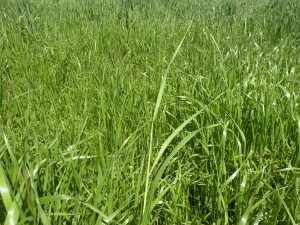Ryegrass haylage: a growing interest
It has finally warmed up and our cool-season grasses are coming out of a long winter’s nap. Now is the time to start thinking about whether producing haylage is an option on your operation. Recently, there has been a renewed interest in producing haylage from annual ryegrass. The following are some common questions on haylage:
What is haylage?
Haylage, baleage, or baled silage are terms often used interchangeably. Haylage is a method of ensiling forage for later use, and involves baling forage at a higher moisture level than dry hay and wrapping bales in plastic. Dry hay, haylage, and silage are all methods of producing stored forage reserves, but each differ in their percent moisture.
Dry hay < 20% moisture
Haylage 40 to 60% moisture
Silage ≥ 65% moisture
Why ryegrass haylage?
Ryegrass is one of the highest quality forages that can be produced in the southeastern USA. Spring rain showers can limit the ability to dry ryegrass down to the right moisture level for hay. Ryegrass haylage can successfully be used to store a higher moisture feed source for use in a winter feeding program.
When is the proper time to harvest ryegrass as haylage?
A major goal of haylage production is to harvest forage at a time that provides both good yield and quality. Ryegrass should be cut for haylage at the time when the flag leaf is beginning to emerge, and baled at 50 to 60% moisture. Wrapping should occur as soon after baling as possible.
What is the nutritional value of ryegrass haylage?
Ryegrass haylage is on average 60 to 65% TDN and 12 to 16% CP. This high value forage can be used to meet the nutrient requirements in most cow-calf operations, and can minimize the need for additional supplemental feed. Due to the high investment in producing haylage, it is important to minimize feeding losses as with hay.
Are there other considerations I need to think about?
The quality of haylage will only ever be as good as what goes into the bag. Haylage additives are designed to help with the ensiling process, but they will not add any extra TDN or CP to the bale than what was there to start with. It is critical to focus on harvesting forages at the proper time to ensure you are getting a quality product from the start!
*For more information on haylage, check out the Haylage/Baleage Production 101 Field Day at E.V. Smith Research Center in Shorter, AL on from 8:30 am to 12:00 pm on May 2, 2014. Contact Josh Elmore (205-646-3610) to register by April 28.

